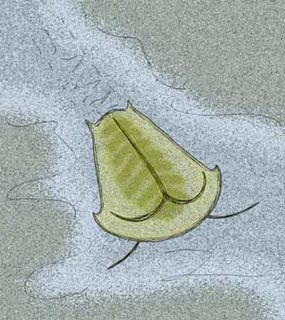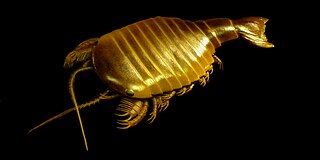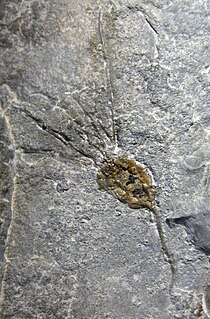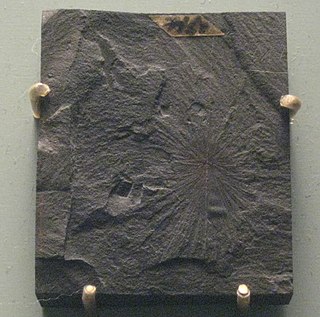
Skania is a Middle Cambrian fossil arthropod that is closely related to the Early Cambrian Primicaris from the Chengjiang Biota, China. It bears a superficial resemblance to the Ediacaran organism Parvancorina. A single specimens of Skania are known from the Greater Phyllopod bed, where they comprise < 0.01% of the community. While previously enigmatic, it is now thought to be a marrellomorph.

Sidneyia is an extinct arthropod known from fossils found from the Early Cambrian-age Maotianshan Shales to the Mid Cambrian Burgess Shale formation of British Columbia. 144 specimens of Sidneyia are known from the Greater Phyllopod bed, where they comprise 0.27% of the community.

Gogia is a genus of primitive eocrinoid blastozoan from the early to middle Cambrian.

Choia is a genus of extinct demosponge ranging from the Cambrian until the Lower Ordovician periods. Fossils of Choia have been found in the Burgess Shale in British Columbia; the Maotianshan shales of China; the Wheeler Shale in Utah; and the Lower Ordovician Fezouata formation. It was first described in 1920 by Charles Doolittle Walcott.

Leanchoilia is an megacheiran arthropod known from Cambrian deposits of the Burgess Shale in Canada and the Chengjiang biota of China. It was about 5 centimetres (2.0 in) long and had long, whip-like feelers mounted on frontal arm-like appendages. Its internal organs are occasionally preserved within the substrate in three dimensions.
Diraphora is an extinct genus of brachiopod that lived in the Cambrian. Its remains have been found in Australia and North America. 664 specimens of Diraphora are known from the Greater Phyllopod bed, where they comprise 1.26% of the community.
Liangshanella is a genus of Cambrian bradoriid known from the Chengjiang biota and Burgess Shale. 6263 specimens of Liangshanella are known from the Greater Phyllopod bed, where they comprise 11.9% of the community.
The Phyllopod bed, designated by USNM locality number 35k, is the most famous fossil-bearing member of the Burgess Shale fossil Lagerstätte. It was quarried by Charles Walcott from 1911–1917, and was the source of 95% of the fossils he collected during this time; tens of thousands of soft-bodied fossils representing over 150 genera have been recovered from the Phyllopod bed alone.
Cambrorhytium is an enigmatic fossil genus known from the Latham Shale (California), and the Chengjiang (China) and Burgess Shale lagerstätte. 350 specimens of Cambrorhytium are known from the Greater Phyllopod bed, where they comprise 0.7% of the community.
Bosworthia is a genus of branching photosynthetic alga known from the Middle Cambrian Burgess Shale. 20 specimens of Bosworthia are known from the Greater Phyllopod bed, where they comprise 0.04% of the community. One of its two original species has since been reassigned to Walcottophycus.
Fieldospongia is a genus of sea sponge known from the Middle Cambrian Burgess Shale. Just five specimens of Fieldospongia are known from the Greater Phyllopod bed, where they comprise less than 0.1% of the community.
Mackenzia is an elongated bag-like animal known from the Middle Cambrian Burgess Shale. It attached directly to hard surfaces, such as brachiopod shells. 14 specimens of Mackenzia are known from the Greater Phyllopod bed, where they comprise <0.1% of the community. Mackenzia was originally described by Charles Walcott in 1911 as a holothurian echinoderm. Later, Mackenzia is thought to be a cnidarian and appears most similar to modern sea anemones.

Molaria is a genus of Cambrian arthropod, the type species M. spinifera is known from the Middle Cambrian Burgess Shale. 144 specimens of Molaria are known from the Greater Phyllopod bed, where they comprise 0.27% of the community. A second species M. steini was described from the Sirius Passet in Greenland in 2017.

Micromitra is a genus of brachiopods known from the Middle Cambrian Burgess Shale. 160 specimens of Micromitra are known from the Greater Phyllopod bed, where they comprise 0.3% of the community.

Lingulella is a genus of phosphatic-shelled brachiopod. It is known from the Middle Cambrian Burgess Shale (Canada) to the Upper Ordovician Bromide Formation in North America. 346 specimens of Lingulella are known from the Greater Phyllopod bed, where they comprise 0.66% of the community.
Leptomitus is a genus of demosponge known from the Middle Cambrian Burgess Shale. Its name is derived from the Greek lept ("slender") and mitos ("thread"), referring to the overall shape of the sponge. 138 specimens of Leptomitus are known from the Greater Phyllopod bed, where they comprise 0.26% of the community.
Paterina is a genus of brachiopods known from the Middle Cambrian Burgess Shale. 18 specimens of Paterina are known from the Greater Phyllopod bed, where they comprise 0.03% of the community.

Priscansermarinus barnetti is an organism known from the Middle Cambrian Burgess Shale which was originally interpreted as a species of lepadomorph barnacle. Four specimens of P. barnetti are known from the Greater Phyllopod bed. A reflective area originally interpreted as external plates has been reinterpreted as a more complex structure inside the body; Derek Briggs, a leading authority on the arthropods of the Burgess Shale, has questioned its assignment as a barnacle or even an arthropod. Its taxonomic status is uncertain.
Protospongia is a genus of Porifera known from the Middle Cambrian Burgess Shale. 102 specimens of Protospongia are known from the Greater Phyllopod bed, where they comprise 0.19% of the community.

Kutorginates are early rhynchonelliform brachiopods.









